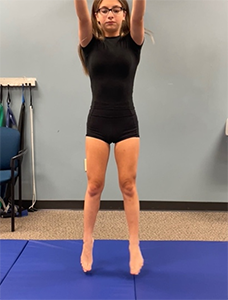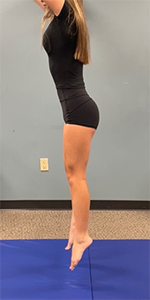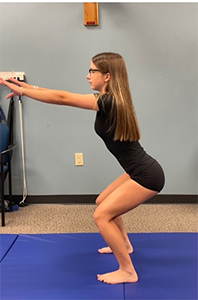
How To Stick the Landing: Landing Mechanics Training for Gymnasts
Leave a CommentThe Olympic Games have a special way of bringing increased interest, awareness, and excitement to the sport of artistic gymnastics. With Simone Biles’ recorded floor tumbling pass height at the summer 2024 Paris Olympic Games achieving over 12 feet, it is imperative that she and gymnasts of all levels land safely. There are approximately 4.57 million artistic gymnasts in the United States1. As gymnasts progress through the sport, the difficulty of the skills increases, and the skills become more dangerous. Gymnastics has one of the highest rates of injury in any girl’s adolescent sport2. One recent study reported that 91.4% of elite gymnasts sustained at least one injury per season3. Another study reported that approximately 70% of gymnastics injuries occur during landing tasks4.
The joint most affected by landing injuries is the ankle, followed by the knee and lumbar spine6. Gymnastics landings require gymnasts to sustain ground reaction forces as high as 7.1-to-15.8 times body weight, which exposes them to an increased risk for injury6. Another factor that increases the risk of injury is the frequency at which these high-force landings are performed weekly. Injuries are associated with practice and competition time loss and training modifications— both of which can tremendously affect the gymnast’s physical and psychological well-being.7
Why Should Gymnasts Learn Proper Landing Mechanics?
Traditional female gymnasts’ landing mechanics have received criticism over the last several years after studies have shown that the upright trunk, feet together, and stiff knee dominant landing style increases the risk for injury8. With the cultural shift from aesthetics to safety, we have seen in gymnastics, as of late, that female gymnasts are starting to land with superior techniques like those seen in men’s gymnastics8. Coaches are training in a squat-dominate landing pattern. This pattern promotes greater lower extremity flexion (bending), which helps dissipate the force that the ankles, knees, and spine must absorb at impact. One study suggests that increased hip flexion, knee flexion, and ankle dorsiflexion at landing reduce the risk for injury by loading posterior chain musculature. This landing style allows the glutes to serve as a shock absorber for vulnerable areas such as the ankle, knee, hip, and spine, including tendons, ligaments, and bones6.
Team Approach for Promoting Safe Landing Strategies
Gymnastics, much like physical therapy, is both a science and an art. Therefore, it is important that we, as coaches, parents, and health care providers, use the available science and research to reduce the risk for injury in adolescent and elite gymnasts.
Gymnastics Landing Pattern Recommended for Safety
- Hip angle approximately 30 degrees from vertical, with trunk and lower leg lines parallel to each other (watch for upright torso)
- Knee angle properly in line with hips (watch for knees falling inward)
- Core activated in spinal neutral position (watch for arched lower back)
- Feet shoulder width apart (watch for feet too close/far apart)
Toe-Ball-Heel Landing Pattern and Daily Drills
When performing jumping skills, it is important to land in a way that dampens the force. This is done by landing in a toe-ball-heel fashion instead of using the entire foot. Add daily landing mechanics drills to your active warm-up to improve your landing mechanics and reduce the risk of landing-related injuries. It can be helpful to start practicing these positions using a chair or a block in front of the mirror for feedback on good mechanics.
1. Double leg hinge squat. This is a squat where the weight is evenly divided over both legs and you are hinging at the hips—no weight is shifting forward, and the heels stay in contact with the ground the entire time.
2. Small double leg jumps with toe-ball-heel landing: Use the take-off position from the double leg hinge squat, swing the arms upward as you leave the ground on the jump. Then the toes contact the ground first during the landing phase as the gymnast moves from the toe to the ball of the foot to the heel, ending in a squat with the arms forward and the heels on the ground.
3. Rebound double leg jump with toe-ball-heel squat landing. The rebound means that you practice performing several squat jumps in a row. The gymnast makes sure to squat during the take-off phase and then landing the toe-ball-heel pattern back into a squat and finishing with a “stuck” landing.
4. Single-leg hinge squat: Perform a similar squat compared to the double leg hinge squat but on 1 leg. The gymnast’s weight should be in the heel of the support leg as she squats down, and the heel stays on the ground the entire time.
5. Small single-leg jump with toe-ball-heel landing. Same mechanics as above with the double leg jump but performed on a single leg.
6. Rebound single leg jump with toe-ball-heel squat landing: Same mechanics as above but the single leg jump is repeated several times taking off of the same leg and landing on that leg. Then repeat the single leg jump on the other leg.
Landing Mechanics Progressions for Active Warm-Up
After you have the above basic landing mechanics down in double and single leg, you can increase the challenge and use these landing mechanics strategies as a fun way to further enhance your dynamic warm-up and improve your landing mechanics with harder tasks.
- Tuck Jump | Pike jump
- In place, double leg ½ turn jump | In place, double leg full turn jump
- In place, single leg 1/4 turn jump | In place, single leg ½ turn jump
- Double leg distance jump x1 | Double leg distance jump x3
- Single leg distance jump x1 | single leg distance jump x3
- Double leg vertical drop jump forwards/backward
- Single-leg vertical drop jumps forwards/backward
If you or your athlete experience pain during practices or competition, connect with our team. They can assess your current condition and provide the best next steps to keep you pain and injury-free. Schedule a free assessment today, and you can be seen in-person at one of our clinic locations or virtually through our telehealth platform.
*Per federal guidelines, beneficiaries of plans such as Medicare, Medicaid, Tricare, VHA and other federally funded plans are not eligible for free assessments.
The Athletico blog is an educational resource written by Athletico employees. Athletico bloggers are licensed professionals who abide by the code of ethics outlined by their respective professional associations. The content published in blog posts represents the opinion of the individual author based on their expertise and experience. The content provided in this blog is for informational purposes only, does not constitute medical advice and should not be relied on for making personal health decisions.
References:
1. https://www.livestrong.com/article/13764418-gymnastics-statistics/
2. https://actabio.pwr.edu.pl/fcp/JGBUKOQtTKlQhbx08SlkTUARAUWRuHQwFDBoIVURNWHlaFVZpCFghUHcKVigEQUw/302/public/publikacje/v19-1-2017/12.pdf
3. https://bmjopensem.bmj.com/content/bmjosem/9/4/e001721.full.pdf
4. https://www.sciencedirect.com/science/article/abs/pii/S1466853X02000706
5. https://pubmed.ncbi.nlm.nih.gov/25984262/
6. https://pubmed.ncbi.nlm.nih.gov/25895434/
7. https://www.sciencedirect.com/science/article/pii/S1466853X22000177
8. https://www.tandfonline.com/doi/full/10.1080/17461391.2021.1976842


















